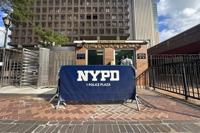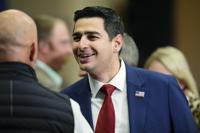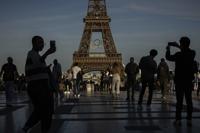NEW YORK (AP) — The New York City police department is lax in punishing officers who illegally stop and frisk people on the street, undermining efforts to curb wrongful uses of the tactic than a judge declared unconstitutional more than a decade ago, a court-ordered study has found.
James Yates, a retired New York state judge, wrote in a report made public Monday that most of the dozens of internal disciplinary cases for stop-and-frisk violations that he reviewed resulted in reduced penalties or no discipline.
“Discipline for illegal stops and frisks” is not pursued “with the same vigor and resolve as for other misconduct,” Yates . “Penalties for wrongdoing involving stops, questions, frisks, or searches of persons, even when repeated, are rare.”
The NYPD's discipline matrix lists a three-day penalty for an illegal stop, frisk or search, but “imposition of that level of discipline is a rarity" and the department's patrol guide permits guidance rather than penalties in “isolated cases of erroneous but good-faith stops or frisks," Yates wrote.
Officers are disciplined either based on the recommendation of a panel at the city’s police watchdog agency, the Civilian Complaint Review Board, or after an internal NYPD investigation. Those findings are sent to the police commissioner, who has the final say on internal discipline and punishment, though some minor or technical infractions are handled at the precinct level.
Over time, NYPD commissioners “have demonstrated an inordinate willingness to excuse illegal stops, frisks, and searches in the name of ‘good faith’ or ‘lack of mal-intention,’” Yates wrote. That prerogative is “relegating Constitutional adherence to a lesser rung of discipline,” he said.
The NYPD said it will review the report and as directed. The CCRB said it is also reviewing the report.
U.S. District Judge Analisa Torres, who has been overseeing NYPD reforms in the wake of the 2013 stop-and-frisk ruling, requested the report — an “in-depth, critical examination of the efficacy, fairness, and integrity” of the NYPD's “policies, practices and procedures” regarding stop-related misconduct.
Torres invited the public, the city and parties to stop-and-frisk-related litigation on the findings by Dec. 25, suggesting she may wait until after that point to take further action.
Center for Constitutional Rights lawyer Samah Sisay said the report's findings “show that even 10 years after the landmark ruling in our cases, the NYPD is failing to address unconstitutional conduct by officers.” Sisay, whose organization filed the lawsuit leading to the 2013 ruling, said: "It is perfectly clear that there is a need for real transparency and accountability because the police should not be trusted to police themselves.”
Yates' findings were posted on Torres' court docket Monday amid upheaval in the NYPD's leadership.
Edward Caban on Sept. 12 after federal authorities seized his electronic devices as part of an investigation that also involved his brother, a former police officer. On Saturday, interim Commissioner Thomas Donlon disclosed that a day earlier, federal authorities . He said they took materials that came into his possession about 20 years ago and are unrelated to his NYPD work.
Yates, who served as a judge in Manhattan criminal and civil courts from 1992 to 2011, on behalf of Mylan Denerstein, the federal monitor whose team helped develop policy, training, supervision and discipline reforms and regularly submits reports to Torres on the NYPD's progress in implementing them.
In 2013, U.S. District Judge Shira Scheindlin ruled that the NYPD had violated the civil rights of Black and Hispanic New Yorkers with its widespread use of stop and frisk. The tactic was part of an effort to get guns and drugs off the street by frequently stopping and searching people.
Scheindlin, now retired, ruled that the stops were a form of indirect racial profiling. Former Mayor Michael Bloomberg, once a champion of the tactic, has since apologized for its use.
Since the ruling, the department has claimed a sharp drop in stops since a high of nearly 686,000 in 2011. The NYPD reported an average of around 12,000 stops per year from 2016 to 2019, dropping to 9,544 in 2020 and 8,948 in 2021. The number of reported stops jumped to 15,102 in 2022, and 16,971 in 2023, according to Yates' report.
Black people continue to be the targets of most stops, the report found, accounting for 59% in 2022 — up from an average of 52% from 2004 to 2012.
Yates recommended that the NYPD take steps to make its disciplinary process more transparent, including by publicizing its procedures and consulting with the court-appointed monitor on any proposed changes to the penalty matrix for stop-and-frisk related misconduct.
Yates also recommended that the NYPD update its online officer directory to show any substantiated stop-and-frisk allegations accepted by the police commissioner, with the date of incident and specific outcome, including guidance or penalty.
If an accused officer asserts that a stop was made in “good faith," or was a “mistake” or that alleged misconduct was an “isolated” incident, the CCRB panel weighing a disciplinary recommendation should be able to evaluate those claims by having access to all prior investigations related to an alleged stop-and-frisk violation, Yates wrote.
“‘Good faith’ or ‘mistakes’ are to be measured objectively,” the retired judge advised, writing that they "must be an objectively reasonable belief or an objectively reasonable mistake measured by the standard of a reasonably trained police officer’s point of view.”








































